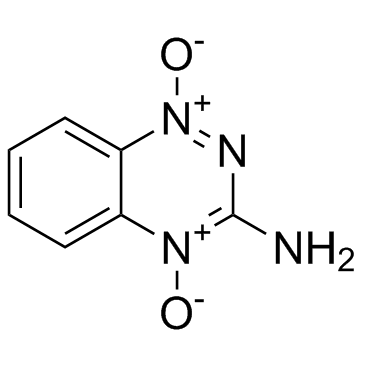Hypoxia-dependent retinal toxicity of NLCQ-1 (NSC 709257) in BALB/c mice. Comparison with tirapazamine.
Maria V Papadopoulou, Ming Ji, William D Bloomer
Index: Basic Clin Pharmacol Toxicol. 108(6) , 396-9, (2011)
Full Text: HTML
Abstract
Bioreductive drugs can cause retinal toxicity, mediated by extensive apoptosis in the outer retina of rodents and monkeys. In the present study, we have investigated whether or not the novel and promising hypoxia-selective cytotoxin 4-[3-(2-nitro-1-imidazolyl)-propylamino]-7-chloroquinoline hydrochloride (NLCQ-1, NSC 709257) can cause hypoxia-dependent retinal toxicity in BALB/c mice alone or in combination with cyclophosphamide (CPM), one of the anti-cancer agents that acts synergistically with NLCQ-1 against mouse tumours and human xenografts. The bioreductive agent tirapazamine (TPZ) was included for comparison purposes. Retinal damage was quantified by morphometric analysis of histological sections following IP treatment of female BALB/c mice. No retinal toxicity was observed with 10 or 22 mg/kg of NLCQ-1 or 23 mg/kg TPZ alone, whereas statistically significant retinal toxicity was observed with the higher TPZ dose of 52 mg/kg (p < 0.001). Thus, a normalized photoreceptor layer thickness (NPT) value of 0.50 ± 0.04, 0.48 ± 0.03 and 0.33 ± 0.06 was determined for untreated, NLCQ-1 and TPZ-treated mice at the highest dose, respectively. Marginal retinal toxicity was observed with the lower dose of TPZ in combination with CPM.© 2011 The Authors. Basic & Clinical Pharmacology & Toxicology © 2011 Nordic Pharmacological Society.
Related Compounds
| Structure | Name/CAS No. | Molecular Formula | Articles |
|---|---|---|---|
 |
Tirapazamine
CAS:27314-97-2 |
C7H6N4O2 |
|
An innovative three-dimensional gelatin foam culture system ...
2015-04-01 [J. Biomed. Mater. Res. B. Appl. Biomater. 103(3) , 618-28, (2015)] |
|
Tirapazamine-doxorubicin interaction referring to heart oxid...
2012-01-01 [Oxid. Med. Cell. Longev. 2012 , 890826, (2012)] |
|
Exploiting tumour hypoxia and overcoming mutant p53 with tir...
1998-06-01 [Br. J. Cancer 77 Suppl 4 , 12-4, (1998)] |
|
A hybrid cellular automaton model of solid tumor growth and ...
2012-01-01 [IEEE/ACM Trans. Comput. Biol. Bioinform. 9(6) , 1595-606, (2012)] |
|
Effects of tirapazamine on experimental colorectal liver met...
2012-04-01 [Br. J. Surg. 99(4) , 576, (2012)] |